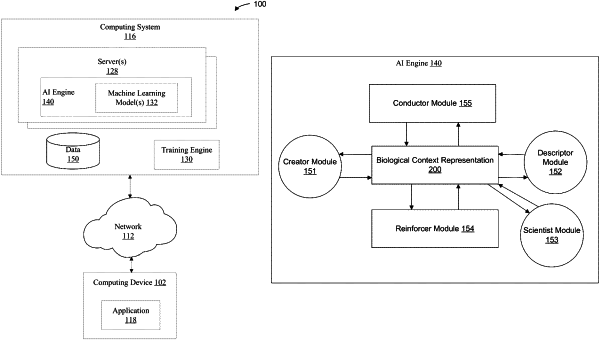| CPC G16B 40/00 (2019.02) [G06F 3/14 (2013.01); G06F 9/451 (2018.02); G06F 16/2428 (2019.01); G06F 16/248 (2019.01); G06F 16/29 (2019.01); G06N 20/00 (2019.01); G16B 5/00 (2019.02); G16B 10/00 (2019.02); G16B 30/00 (2019.02); G16B 35/00 (2019.02); G16B 45/00 (2019.02); G16C 20/70 (2019.02); G16H 10/20 (2018.01); G16H 50/20 (2018.01); G16H 50/70 (2018.01); G16H 70/40 (2018.01); G06Q 30/0201 (2013.01); G06Q 50/04 (2013.01); G06Q 50/184 (2013.01); G16H 40/20 (2018.01)] | 20 Claims |

|
1. A method for presenting, on a computing device, a graphical user interface (GUI) of a therapeutic tool, the method comprising:
presenting, in a first screen of the GUI, a design space for a protein for an application, wherein the design space comprises a plurality of protein sequences, wherein:
each protein sequence is associated with a respective plurality of activities pertaining to the application,
and
the plurality of protein sequences is generated by a machine learning model, wherein the machine learning model uses causal inference to execute at least one of a plurality of alternative scenarios to filter a superset of protein sequences and to generate the plurality of protein sequences in the design space;
receiving via a graphical element, a selection of one or more query parameters of the design space; and
presenting, in a second screen of the GUI, a solution space comprising a subset of the plurality of protein sequences, wherein each protein sequence contains the respective plurality of activities, wherein the second screen comprises:
a first portion presenting one or more color-coded clusters representing the subset of the plurality of protein sequences, and
a second portion presenting data pertaining to the subset of the plurality of protein sequences represented by the one or more color-coded clusters, wherein the data describes one or more objects associated with the subset of the plurality of protein sequences, and wherein the subset of the plurality of protein sequences is based on an indication that the protein sequence has not been previously generated by the machine learning model and wherein the one or more objects comprise a candidate drug compound, an activity, an interaction, a drug, a gene, a pathway, a physical descriptor, a characteristic, an interaction, a folding property, a wave property, a stability of modification, or some combination thereof.
|